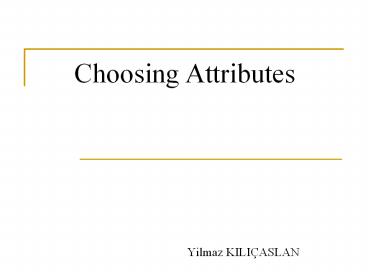Choosing Attributes PowerPoint PPT Presentation
1 / 10
Title: Choosing Attributes
1
Choosing Attributes
Yilmaz KILIÇASLAN
2
Choosing attribute tests
- The scheme used in decision tree learning for
selecting attributes is designed to minimize the
depth of the final tree. - The idea is to pick the attribute that goes as
far as possible toward providing an exact
classification of the examples. - A perfect attribute divides the examples into
sets that are all positive or all negative. - The Patrons attribute is not perfect, but it is
fairly good. A really useless attribute, such as
Type, leaves the example sets with roughly the
same proportion of positive and negative examples
as the original set. - All we need, then, is a formal measure of "fairly
good" and "really useless. - The measure should have its maximum value when
the attribute is perfect and its minimum value
when the attribute is of no use at all.
3
Amount of Information - I
- One suitable measure is the expected amount of
information provided by the attribute, where we
use the term in the mathematical sense first
defined in Shannon and Weaver (1949). - Information theory measures information content
in bits. - One bit of information is enough to answer a
yes/no question about which one has no idea, such
as the flip of a fair coin.
4
Amount of Information - II
- In general, if the possible answers vi have
probabilities P(vi), then the information content
I of the actual answer is given by
5
Amount of Information - III
- For decision tree learning, the question that
needs answering is for a given example, what is
the correct classification? - An estimate of the probabilities of the possible
answers before any of the attributes have been
tested is given by the proportions of positive
and negative examples in the training set. - Suppose the training set contains p positive
examples and n negative examples. Then an
estimate of the information contained in a
correct answer is
6
Amount of Information - IV
- A test on a single attribute A will not usually
tell us all the information, but it will give us
some of it. - We can measure exactly how much by looking at how
much information we still need after the
attribute test. - Any attribute A divides the training set E into
subsets E1, . . . , Ev, according to their values
for A, where A can have v distinct values. - Each subset Ei has pi positive examples and ni
negative examples, so if we go along that branch,
we will need an additional I(pi/(pi ni), ni/(pi
ni)) bits of information to answer the
question.
7
Amount of Information - V
- A randomly chosen example from the training set
has the ith value for the attribute with
probability (pi n i ) / ( p n), so on
average, after testing attribute A, we will need
the following amount of information to classify
the example
8
Amount of Information - VI
- The information gain from the attribute test is
the difference between the original information
requirement and the new requirement
9
Amount of Information - VII
- The heuristic used in the CHOOSE-ATTRIBUTE
function is just to choose the attribute with the
largest gain. Returning to the attributes
considered in Figure 3 in the preceding
presentation, we have - Gain(Patrons) 0.541 bits.
10
Reference
- Russell, S. and P. Norvig (2003). Artificial
Intelligence A Modern Approach. Prentice Hall.

